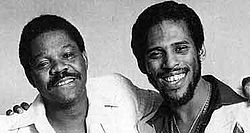- McFadden & Whitehead
-
McFadden & Whitehead 
Gene McFadden (left) and John Whitehead (right)Background information Origin Philadelphia, Pennsylvania, United States Genres R&B, funk, disco Years active 1970s Labels Philadelphia International Associated acts Teddy Pendergrass
Harold Melvin & The Blue Notes
The O'Jays
MFSBPast members Gene McFadden
John WhiteheadMcFadden and Whitehead were an American songwriting, production, and recording duo, best known for their signature tune "Ain't No Stoppin' Us Now". They wrote and produced some of the most popular R&B hits of the 1970s, and were primarily associated with Gamble and Huff's Philadelphia International soul music record label[1]
Contents
Early career
When they were teenagers, Gene McFadden and John Whitehead formed a group called The Epsilons. The personnel included Allen Beatty, James Knight, and future Blue Notes member Lloyd Parks.[2] They were discovered by Otis Redding and toured with him during the late 1960s until Redding's death in a plane crash in 1967.
The duo later joined Philly International Records, where they wrote hit after hit, the first being "Back Stabbers" in 1972 for the O'Jays. It became #1 across the board in one week.
McFadden and Whitehead also wrote hits such as " I'll Always Love My Momma," "Bad Luck," "Wake Up Everybody," "Where Are All My Friends," "The More I Get, The More I Want", and "Cold, Cold World". The production team also worked with Melba Moore, Freddie Jackson, Producer/ Rahni Song and Gloria Gaynor, Teddy Pendergrass, Harold Melvin & The Blue Notes, Gladys Knight, The Jackson 5, James Brown, Stevie Wonder, Lou Rawls, Archie Bell & the Drells, and The Intruders.[3]
Rise to stardom
McFadden and Whitehead formed together as a group officially under the name "McFadden & Whitehead" in 1977. The pinnacle of their success came in 1979 with "Ain't No Stoppin Us Now," which went to #1 on the R&B charts, #13 on the pop charts, sold eight million records worldwide and was nominated for a Grammy Award. The duo was featured on the Oprah Winfrey Show, where they sang their most famous song on an episode in which Oprah featured the top hits of the 1970s.
Other hits included:
- "I Got The Love"
- "You're My Somebody to Love"
- "I've Been Pushed Aside"
- "Got to Change"
- "Do You Want to Dance?"
- "Just Wanna Love You Baby"
- "Mr. Music"
- "This Is My Song"
Deaths
On May 11, 2004, Whitehead was murdered while working on his car with his nephew on the street outside of his Philadelphia home. In an apparent case of mistaken identity, he was shot by two unknown gunmen, who then fled. The case remains unsolved. Whitehead was 54 years old.
On January 27, 2006, McFadden died of liver and lung cancer. He was 57.
References
External links
Categories:- American rhythm and blues musical groups
- Disco groups
- Philadelphia International Records artists
- Musical groups from Philadelphia, Pennsylvania
- American record producers
- Record production teams
- American soul musical groups
Wikimedia Foundation. 2010.
